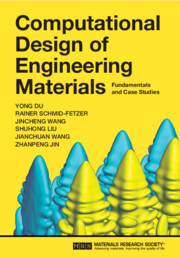310 results
The amino acid sensor MetRS is required for methionine-induced milk protein synthesis in a domestic pigeon model
-
- Journal:
- British Journal of Nutrition / Accepted manuscript
- Published online by Cambridge University Press:
- 03 June 2024, pp. 1-34
-
- Article
-
- You have access
- Export citation
Spatial–temporal distribution characteristics of pulmonary tuberculosis in eastern China from 2011 to 2021
-
- Journal:
- Epidemiology & Infection / Volume 152 / 2024
- Published online by Cambridge University Press:
- 15 May 2024, e84
-
- Article
-
- You have access
- Open access
- HTML
- Export citation
Phylogenetic trends in TZ staining analysis of six deep dormancy seeds
-
- Journal:
- Seed Science Research , First View
- Published online by Cambridge University Press:
- 15 April 2024, pp. 1-13
-
- Article
-
- You have access
- Open access
- HTML
- Export citation
Effect of dietary selenium intake on CVD: a retrospective cohort study based on China Health and Nutrition Survey (CHNS) data
-
- Journal:
- Public Health Nutrition / Volume 27 / Issue 1 / 2024
- Published online by Cambridge University Press:
- 27 March 2024, e122
-
- Article
-
- You have access
- Open access
- HTML
- Export citation
Evaluation of the psychometrics of the Social Impact Scale and its association with depression among asymptomatic COVID-19 carriers
-
- Journal:
- BJPsych Open / Volume 10 / Issue 2 / March 2024
- Published online by Cambridge University Press:
- 01 February 2024, e41
-
- Article
-
- You have access
- Open access
- HTML
- Export citation
Synthesis and Adsorption Desulfurization Performance of Modified Mesoporous Silica Materials M-MCM-41 (M = Fe, Co, Zn)
-
- Journal:
- Clays and Clay Minerals / Volume 67 / Issue 4 / August 2019
- Published online by Cambridge University Press:
- 01 January 2024, pp. 325-333
-
- Article
- Export citation
Plasma Spectroscopy on Hydrogen-Carbon-Oxygen Foam Targets Driven by Laser-Generated Hohlraum Radiation
-
- Journal:
- Laser and Particle Beams / Volume 2022 / 2022
- Published online by Cambridge University Press:
- 01 January 2024, e15
-
- Article
-
- You have access
- Open access
- HTML
- Export citation
Laterite as a Potential Seepage Barrier From a Karst-Depression Tailings Impoundment
-
- Journal:
- Clays and Clay Minerals / Volume 69 / Issue 1 / February 2021
- Published online by Cambridge University Press:
- 01 January 2024, pp. 1-22
-
- Article
- Export citation
Preparation and Properties of Antibacterial Polyhexamethylene Biguanide/Palygorskite Composites as Zearalenone Adsorbents
-
- Journal:
- Clays and Clay Minerals / Volume 70 / Issue 2 / April 2022
- Published online by Cambridge University Press:
- 01 January 2024, pp. 182-195
-
- Article
- Export citation
The Charge State of Protons with 90 and 100 keV Energies Decelerated in Hydrogen Plasma
-
- Journal:
- Laser and Particle Beams / Volume 2021 / 2021
- Published online by Cambridge University Press:
- 01 January 2024, e15
-
- Article
-
- You have access
- Open access
- HTML
- Export citation
The Formation and Transformation of Manganese Oxide Minerals on the Surface of Kaolinite
-
- Journal:
- Clays and Clay Minerals / Volume 71 / Issue 1 / February 2023
- Published online by Cambridge University Press:
- 01 January 2024, pp. 106-118
-
- Article
- Export citation
International political relations on the anxiety disorders of Sino-Japanese Marine literature exchange
-
- Journal:
- CNS Spectrums / Volume 28 / Issue S2 / October 2023
- Published online by Cambridge University Press:
- 27 October 2023, p. S73
-
- Article
-
- You have access
- Export citation
Associations of dietary and sedentary behaviours of pregnant women with their children’s birth weight: findings from the CHAT trial in Australia
-
- Journal:
- Public Health Nutrition / Volume 26 / Issue 12 / December 2023
- Published online by Cambridge University Press:
- 16 October 2023, pp. 2859-2867
-
- Article
-
- You have access
- Open access
- HTML
- Export citation
Determinants of measles persistence in Beijing, China: A modelling study
-
- Journal:
- Epidemiology & Infection / Volume 151 / 2023
- Published online by Cambridge University Press:
- 22 August 2023, e144
-
- Article
-
- You have access
- Open access
- HTML
- Export citation
5 - Fundamentals of Computational Thermodynamics and the CALPHAD Method
-
- Book:
- Computational Design of Engineering Materials
- Published online:
- 29 June 2023
- Print publication:
- 29 June 2023, pp 113-197
-
- Chapter
- Export citation
10 - Case Studies on Cemented Carbide Design
-
- Book:
- Computational Design of Engineering Materials
- Published online:
- 29 June 2023
- Print publication:
- 29 June 2023, pp 342-369
-
- Chapter
- Export citation

Computational Design of Engineering Materials
- Fundamentals and Case Studies
-
- Published online:
- 29 June 2023
- Print publication:
- 29 June 2023




